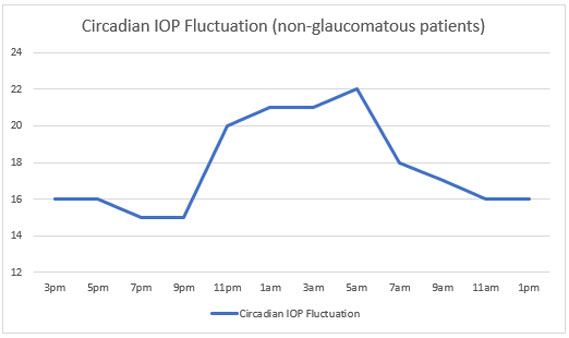BLOG: How does IOP change when we sleep?
Last month we talked about how long it takes for IOP medications to wash out of a patient’s system. We found that some medications washed out faster during daytime hours, but still had effects during nighttime hours.
This brought up a lot of questions, so this month I wanted to dive into the circadian fluctuations of IOP.
The first thing to know about this topic is that IOP changes during the day, and, for most humans, it’s highest during nighttime hours. See the accompanying graph. This is a problem because the IOP is highest for our patients during the times we never measure it: while they’re sleeping.
This trend is the same in glaucoma patients, only it fluctuates even higher. This could be one reason why your patient with glaucoma shows signs of progression even though her IOP in your office is controlled – because she’s spiking during her sleep.
But why is IOP higher during sleep? The answer has to do with our posture. Most humans lie down to sleep, in some variation of supine/recumbent/prone position. The literature mostly refers to supine position, so I will use supine as the example, but the positions’ effects on IOP are essentially the same.
The increase in IOP is thought to be explained by the hydrostatic increase in the pressure of the episcleral and orbital veins during supine positioning. Aqueous humor is eventually drained into the episcleral veins, and if the episcleral venous pressure (ESVP) increases, IOP will increase (ESVP typically contributes 8 mm Hg to 10 mm Hg to the IOP). And keep in mind, the IOP is increasing at night despite the fact that the rate of aqueous humor formation decreases during dark/sleep period. The ESVP is that important to IOP.
I found these studies that I reference very interesting reading and would encourage you to check them out. They all took different approaches to the problem of measuring IOP during nighttime (which would be too long to detail here), some measuring IOP with a pneumotonometer, handheld applanation tonometer, Tono-Pens (Reichert) or handheld noncontact tonometer.
The reason that nocturnal IOP elevation is so important is because: the increase is greater for glaucoma patients and the increase coincides with the time when our systemic blood pressure is the lowest. If IOP increases and blood pressure decreases, the ocular perfusion pressure will decrease, leaving it at greater risk for glaucomatous damage.
Think about your (diurnally) normotensive glaucoma patients who are progressing despite IOP of 11 mm Hg. How could we know if they’re spiking while they lie down to sleep? Well, you could ask them to lie down. Fogagnolo and colleagues found, “that supine measurements during office hours can improve the estimate of the characteristics of the 24-hour IOP curve in patients with glaucoma.” The effect of ESVP can be found in IOP in as quick as 2 minutes in a supine position, so although it might be awkward to ask Mr. Smith to lie down on the clinic floor, at least you wouldn’t have to leave him lying there for too long. Knowing the condition of the floors at my hospital, if I were to do this, then I would have to have some pre-cleaned exam room to use!

IOP (shown here in mm Hg) changes during the day, reaching its highest points at night. Source: Doug Rett, OD, FAAO
Sleeping is one thing, but yoga is another. There are several studies on yoga and IOP, and all of them that I read found a significant (but reversible) increase in IOP. Specifically, head-down positions (like Sirsasana, Svanasana and Uttanasana) have been found to increase IOP up to double the baseline pressure. This effect happens within 2 minutes of assuming the position and normalizes within 10 minutes of resuming normal posture. Most of the studies were performed on younger patients without glaucoma (presumably because it might be dangerous to put older glaucoma patients in head-stands), so we don’t know if the results are the same on glaucoma patients. However, based on the supine experiments, one can assume that the IOP increase would be at least the same, if not greater for glaucoma patients in head-down positioning.
Nocturnal IOP elevation is something we should consider in all our patients when managing IOP, but especially in (diurnally) normotensive patients that seem to continue to progress, as well as in patients who are confined to their bed for much of the day. After all, we spend (or should spend) a third of our lives in the supine position.
References:
Barkana Y, et al. Arch Ophthalmol. 2006;doi:10.1001/archopht.124.6.793.
Baskaran M, et al. Ophthalmology. 2006;doi:10.1016/j.ophtha.2006.02.063.
Fogagnolo P, et al. Invest Ophthalmol Vis Sci. 2009;doi:10.1167/iovs.08-2889.
Hara T, et al. Arch Ophthalmol. 2006;doi:10.1001/archopht.124.2.165.
Jasien JV, et al. PLoS ONE. 2015;doi.org/10.1371/journal.pone.0144505.
Jorge J, et al. J Glaucoma. 2010;19:609-612.
Liu JH, et al. Invest Ophthalmol Vis Sci. 1998;39:2707-2712.
Mosaed S, et al. Am J Ophthalmol. 2005;doi:10.1016/j.ajo.2004.09.062.
Shields MB. Textbook of Glaucoma. 4th ed. Williams & Wilkins; 1998.
